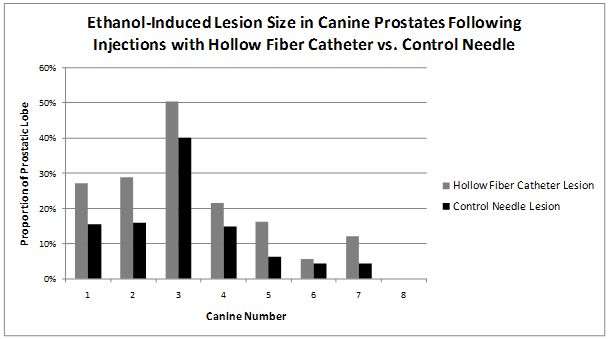|
Back to 2011 Program
Comparison of Intraprostatic Ethanol Diffusion Using a Microporous Hollow Fiber Catheter vs. Standard Needle
Benjamin J King1, Mark K Plante1, Masatoshi Kida1, Travis K Man-Gow1, Rick Odland2, Peter Zvara1
1University of Vermont, Burlington, VT;2Twin Star Medical, Minneapolis, MN
Introduction:
Transurethral intraprostatic ethanol chemoablation of the prostate has demonstrated promising preliminary clinical Results for treatment of BPH with some variability in clinical outcomes. This is likely due to injectable backflow along the needle tract with uneven prostatic distribution. The Objective of this study was to compare tissue diffusion of an intraprostatic injection using a new microporous hollow fiber catheter (MiHFC) to that of a standard needle.
Materials & Methods:
The prostates of eight mongrel dogs (weighing 70 - 88 lbs) were exposed and a single injection of 99% ethanol was delivered into each lobe using the MiHFC and a standard needle. The prostates were harvested and fixed en block in 10% formalin. The lesions were traced on scanned hematoxylin & eosin histology sections. Three dimensional reconstructions were performed using 2.5 mm step-sections. The volume of each ethanol-induced prostatic lesion was calculated using stereology.
Results:
Ethanol-induced tissue changes were seen bilaterally in seven of eight prostates injected. One prostate was harvested without injection, acting as a negative control. Statistical analysis of data compiled from all treated prostates showed significantly larger histological changes (p ≤ 0.01) on the side injected by the MiHFC (Figure).

Conclusions:
The use of a MiHFC consistently resulted in larger ethanol-induced tissue lesions. The advantage shown with the MiHFC indicates its potential for developing into a new method to treat prostate disease.
Back to 2011 Program
|